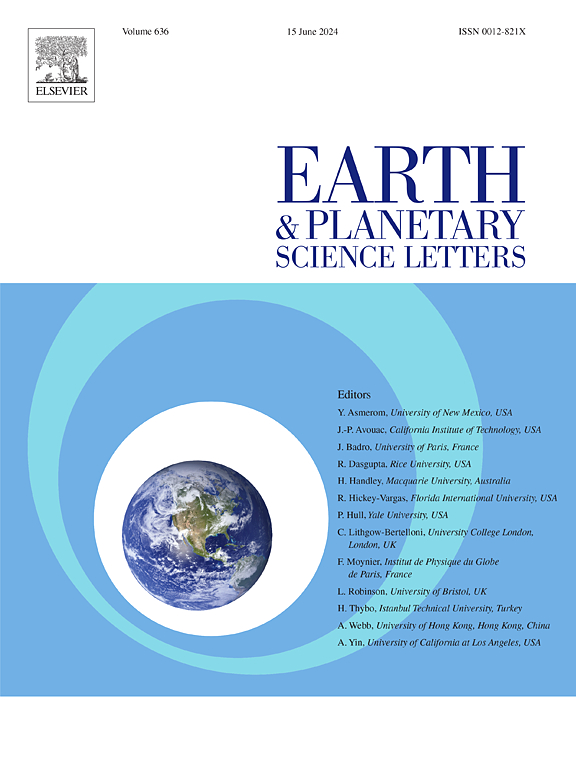珊瑚文石中块状同位素的快速热重置
IF 4.8
1区 地球科学
Q1 GEOCHEMISTRY & GEOPHYSICS
引用次数: 0
摘要
生物文石是重要的地质信号档案,其块状同位素分析可以提供古环境信息。然而,块状同位素(Δ47)的热重置是一个重大挑战,特别是在经历成岩蚀变或埋藏加热的深时间碳酸盐样品中。实验室加热实验和动力学建模为限制碳酸盐的初始团块同位素组成和热历史提供了重要的见解。热复位在方解石、白云石和磷灰石中得到了广泛的研究。然而,加热过程中的矿物相变以及由此产生的多相混合物使加热实验数据拟合文石的热重置动力学模型变得复杂。在这里,我们提出了加热实验,旨在评估文石相变之前的热重置动力学参数。我们将珊瑚文石材料以三种形式处理——破碎、粉状和氧化,并在120-240°c下加热,以评估不同类型的内部水对热复位的作用。我们观察到文石的Δ47值在实验加热的初始阶段迅速下降,在40 min左右明显放缓。同时,我们观察到氧同位素值在加热过程中下降,这表明内部水与固体碳酸盐之间的同位素交换。我们观察到破碎珊瑚和粉状珊瑚的热重置率没有显著差异;然而,与其他两种样品类型相比,氧化珊瑚的热重置速率表现出有限的加速。我们推断氧化文石中有限的加速热重置速率可能是由于氧化预处理过程中有机物的部分去除,这增加了表面体积比,促进了内部水(可能来自纳米级有机相关水或结构水)通过新形成的微裂缝和微通道迁移。将加热数据拟合到无序动力学模型中,得到了珊瑚文石的热重置动力学参数。平均活化能(μE)为132.0±12.4 kJ mol⁻¹,活化能分布宽度(σE)为10.9±0.7 kJ mol⁻¹,指数前因子(ν0)为30.5±3.6 min⁻¹。为了更好地了解珊瑚文石的长期行为,我们模拟了珊瑚文石在20-200°C温度范围内的热历史。模拟表明,在100℃以上的温度下,珊瑚文石的Δ47值在一年内达到完全平衡。而在50℃以下,珊瑚文石的块状同位素信号易发生蚀变。这些结果表明,在深时间研究中使用珊瑚文石块状同位素应谨慎处理。然而,珊瑚文石对热重置的高度敏感性使其块状同位素信号可作为成岩指示物。当与共存的碳酸盐相一起分析时,文石的T(Δ47)可以为共存矿物的T(Δ47)值的解释提供额外的约束。本文章由计算机程序翻译,如有差异,请以英文原文为准。
Rapid thermal resetting of clumped isotope in coral aragonite
Biogenic aragonite serves as a critical archive of geological signals, and its clumped isotope analysis can provide paleoenvironmental information. However, the thermal resetting of clumped isotope (Δ47) presents a major challenge, especially in deep-time carbonate samples subjected to diagenetic alteration or burial heating. Laboratory heating experiments and kinetic modeling offer important insights into constraining the initial clumped isotope composition and thermal history of carbonates. Thermal resetting has been extensively studied in calcite, dolomite, and apatite. However, mineralogical phase transitions during heating, and the resulting multiphase mixtures complicate the fitting of heating experiment data to thermally reset kinetic models for aragonite. Here, we present heating experiments designed to evaluate the thermal resetting kinetic parameters of aragonite prior to phase transitions. We treated coral aragonite materials in three forms—fragmented, powdered, and oxidized and heat them at 120–240 °C—to evaluate the role of different types of internal water on thermal resetting. We observed a rapid decrease in the Δ47 values of aragonite during the initial stage of the experimental heating, which slowed significantly around 40 min. Meanwhile, we observed a decrease in oxygen isotope values during heating suggesting the isotopic exchanges between the internal water and the solid carbonate. We observed no significant difference in the thermal resetting rates between fragmented coral and powdered coral; however, oxidized coral thermal resetting rate exhibited limited acceleration compared to the other two sample types. We infer that the limited accelerated thermal resetting rate in oxidized aragonite may be due to the partial removal of organic matter during oxidative pretreatment, which increases the surface-to-volume ratio, facilitating the migration of internal water—potentially sourced from nanoscale organic-associated water or structural water—through newly formed microfractures and microchannels. The thermal resetting kinetic parameters of coral aragonite were derived by fitting the heating data to the disordered kinetic model. The mean activation energy (μE) is 132.0 ± 12.4 kJ mol⁻¹, the activation energy distribution width (σE) is 10.9 ± 0.7 kJ mol⁻¹, and the pre-exponential factor (ν0) is 30.5 ± 3.6 min⁻¹. To better understand the long-term behavior, we simulated the thermal history of coral aragonite across a temperature range of 20–200 °C. The simulations indicate that, at temperatures above 100 °C, the Δ47 values of coral aragonite reach complete equilibrium within one year. Meanwhile, below 50 °C, the clumped isotope signal of coral aragonite is susceptible to alteration. These results suggest that the use of coral aragonite clumped isotopes in deep-time studies should be approached with caution. However, coral aragonite’s high sensitivity to thermal resetting makes its clumped isotope signals useful as a diagenetic indicator. When analyzed alongside coexisting carbonate phases, the T(Δ47) of aragonite can provide additional constraints on the interpretation of T(Δ47) values in those coexisting minerals.
求助全文
通过发布文献求助,成功后即可免费获取论文全文。
去求助
来源期刊

Earth and Planetary Science Letters
地学-地球化学与地球物理
CiteScore
10.30
自引率
5.70%
发文量
475
审稿时长
2.8 months
期刊介绍:
Earth and Planetary Science Letters (EPSL) is a leading journal for researchers across the entire Earth and planetary sciences community. It publishes concise, exciting, high-impact articles ("Letters") of broad interest. Its focus is on physical and chemical processes, the evolution and general properties of the Earth and planets - from their deep interiors to their atmospheres. EPSL also includes a Frontiers section, featuring invited high-profile synthesis articles by leading experts on timely topics to bring cutting-edge research to the wider community.
 求助内容:
求助内容: 应助结果提醒方式:
应助结果提醒方式:


